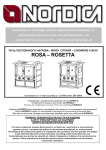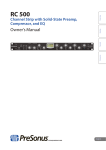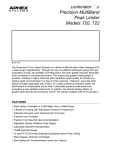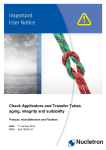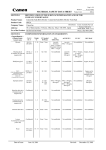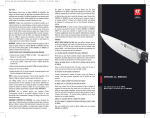Download Professional metal detector
Transcript
CS770 Professional metal detector Operating manual Gebruikers handleiding Manuel de l’Utilisation CS-770 METAL DETECTOR INTRODUCTION You are now the owner of a CS-770 metal detector. These detectors are recognised as one of the finest metal detectors available. The are designed and manufactured to the highest standard to give you the maximum enjoyment and success. In order to obtain the best results it is IMPORTANT that you read and follow these instructions. CONTROLS AND FEATURES A B C D E F G I - On/Off Tune Control - Discriminate Level Control - Auto Tune Button - Meter - Battery Check - Battery Compartment - Battery Compartment - Search Head Diagram 1 CS-770 1 GB ASSEMBLY AND BATTERIES Your CS-770 comes to you broken down for packaging. To assemble, insert the thickest pipe with drilled holes into control box underside and secure with the 2 bolts provided, slacken the knurled locking collar on the top stem and insert the middle stem. Insert the lower stem in the middle stem and tighten locking collar. Twist the head cable around the stems until the slack is taken up, then connect the head to the lower stem using the bolt provided. Height adjustment can be achieved by slackening off the knurled locking collars and extending or shortening the whole assembly. BATTERIES Before you can operate your CS-770 you need to purchase 4 x PP3 batteries, preferably by a well known manufacturer. N.B. Over 80% of all faults occurring with metal detectors can be traced to poorly fitted or faulty batteries - even new ones ! By removing battery covers (F and G) access is gained to the battery compartments. To remove battery covers gently depress ribbed and slide forward. Connect batteries firmly onto battery clips and replace battery covers. Battery life will be longer if headphones are used. Diagram 2 CS-770 2 GB BATTERY CHECK As a guide to battery condition a battery check is provided (E). To check batteries, simply depress button (E) (N.B. machine must be switched on) and note the position of the meter needle, the further the needle is to the right of the "Change Battery" mark the better the condition of the batteries. TUNING YOUR DETECTOR First switch on knob (A) and whilst depressing Auto Tune Button (C) turn clockwise until a faint noise is heard (and the meter needle centres). Then release Auto Tune Button. The best optimum tuning point is where the sound can just be heard if the machine is operated on a silent setting of where the noise is too loud sensitivity will be lost. N.B. Before tuning machine ensure no metal objects are in the vicinity. RE-TUNING Should the detector go out of tune for any reason, e.g., changes in temperature or ground conditions, encounters with large metal objects or an alteration of the discriminate control, simply depress the auto tune button and the detector will return to the pre-selected optimum tuning point. DISCRIMINATION The CS-770 has a variable discrimination control which allows the operator to choose from any setting between all metal detection (Reject 0) to iron and silver paper rejection (Reject 10). To adjust the Discriminate Level Control (B) depress the Auto Tune Button turn discriminate level control to the desired level and release Auto Tune Button. Discrimination of a target object is indicated by a reduction in signal strength and by the meter moving to the left. For example, with the reject setting at 5 an iron nail will give a negative reaction (reduction in sound, meter moves to the left) whereas on a coin there will be a positive reaction (an increase in sound and a meter movement to the right). All metal detector discriminations suffer from anomalies when objects are close to the search head. This is indicated by receiving a positive and negative reaction from the same object. If this occurs simply raise the detector about 3" re-tune and scan again. CS-770 3 GB GROUND EFFECT The signal of your detector will be affected by the type of terrain you are searching. Normally this effect produces an increase or decrease in the audio signal when the search head is raised from the ground. This effect can be controlled in two ways. If the search head is kept at a constant height the effect of the ground will be constant. The second method should only be used when the effect is severe. This method is to de-tune the machine so that it is less sensitive to the ground. However this will have the effect of making the machine less sensitive to coins as well. USE OF YOUR DETECTOR IN THE FIELD Detecting To test for the type of signal you will get, take a coin or metal object and with the detector set up on a table tuned as previously described, move the metal object towards and across the search head. You will note that the volume will increase quickly as the metal object passes across the search head, with the loudest sound occurring when the search head is immediately centred over the metal object. As the object passes beyond the search head the sound will quickly fade. The metal detectors employ a Total Response search head which means that the object can be detected across the full width, back to front, of the search head. See Diagram 3 Transmit Coil Search area Pick-up area Receive coil Detection Range Detection ranges will vary depending on the size of the object, the length of time an object has been buried in. The best ground conditions are dry well compacted soils then coins can be found at the greatest depths if they have been buried for some time and the coin has interacted with the salts in the ground, thereby appearing larger to the detector. The worst conditions for detecting are on loosely compacted or freshly dug ground or when the object has only recently been buried. In these conditions detection range will be reduced. 90% of all objects are found within 6" (20 cm) of the surface. Adverse soil conditions can reduce depth of detection by more than half. CS-770 4 GB Determining the Target Size and Depth An operator who is familiar with his instrument will be able to do an excellent job of determining object size, shape and depth before he digs. The technique is learned from careful analysis of the audio signals coming from the detector. Each time a signal is heard, listen for any peculiar characteristics it may have ; determine over how large an area you get a detector signal ; and try to "outline" the object before you dig. Listen for the sharpness or dullness of the signals and determine the magnitude of strength of the signal. A coin will have a sharp signal, a nail a fuzzy signal. RECOMMENDATIONS FOR USE Treasure hunting can be a profitable and rewarding hobby, if approached in a patient and diligent manner. Time spent researching to locate a worthwhile site for a search can be time wasted if your search is hasty and erratic. To achieve maximum results, it is important, then, to decide on your approach to each particular site, in advance of the actual search. Tactics will be decided by the type of site - it is more profitable to scan a small area thoroughly than to conduct a haphazard search of the total site. However, when the site is too far away for you to make several return visits, a plan should be adopted which gives maximum site coverage, at the same time as indicating the most likely areas for detailed search. One method is to divide the area into large squares of a ’criss-cross’ search pattern, starting along the left hand perimeter, search in a straight line, marking the location of any finds with small sticks, until you have covered the length of the site. Then, moving approximately ten feet (3m) to the right, search in a straight line parallel to the first line of search. This pattern should be repeated until the right hand perimeter is reached ; then follow a similar pattern ACROSS the tracks of the first lines of search. (See diagram 4). It quite often happens that where one find is made, other finds will be made in the immediate vicinity. Accordingly, places having the highest density of markers, placed where finds were made, represent the most likely spots for further finds. The detailed search is made by marking out strips of a width determined by the sweep of the detector, and moving forwards the approximate diameter of the search head after each sweep until the ’strip’ has been completely covered. The adjacent strips are covered in a similar manner, until the complete area has been thoroughly searched. (see diagram 5). Wooden pegs and string are ideal for marking out areas, but very often natural land marks such as trees, rocks and plants can, with practice, prove just as effective. CS-770 5 GB Whilst searching it is important to remember that the search head should be kept as close to the ground as possible. This ensures maximum depth penetration. There is a maximum detection range and a large gap between head and ground reduces the effective depth of the search. See diagram 6. Diagram 4 FINISH Diagram 5 LINE OF SWEEP START On arrival at the site a criss-cross is made marking the positions of finds : 1, 2, 3, 4 and 5. A detailed search of the area around the finds is made on completion of the criss-cross search. Diagram 6 It is essential that the search head is kept close and parallel to the ground to avoid missing finds as in A, C and D. An area ten foot square is marked out around the find located by criss-cross search. This is then divided into strips which are carefully searched. Distance A = width of the detector’s pick-up area Distance B = length of a comfortable sweep CARE AND MAINTENANCE Care of Your Detector The working life of your detector will be shortened by careless use or neglect of the unit. Think of your detector as a scientific instrument NOT A TOY. Your detector is designed to withstand rugged handling on any terrain, but mis-use or lack of due attention will tell in the end. After using your detector in a hostile environment (salt water, sand, etc.), the exterior parts of the casing should be flushed with fresh water, paying particular attention to the head, and carefully wiped dry. Foreign particles in the control box can be removed by brushing carefully (or with compressed air or vacuum cleaner). CS-770 6 GB Salt Damage If you use your detector continually in a salty environment, particularly when the wind is blowing off the sea, salty air can penetrate the control box. Corrosion can occur in vital parts of the delicate electronic circuitry. It is, therefor, recommended that precautions such as covering the control box with polythene be taken to avoid damage. The guarantee cannot cover such occurrences and any repairs needed because of salt water or spray will be charged. The Use of Solvents It has been found that some types of solvent used for cleaning circuitry will in fact melt the plastic covered components. Clean the circuit board only with recognised circuit board cleaning agents. The life of the controls may be extended by periodic (100 hours of use) application of small quantities of light lubricant to the spindles, threads and knob grub screws (’3 in 1’ or similar household oil is suitable). This operation requires the knobs to be removed. Light packing grease should be smeared on the threads of the locking collar, and at the same time, the head fixing bolt. Do not store the detector in a damp place. If the detector is to be stored, remove the batteries as the may leak and corrode the surrounding electronics. Detector Not Operating (a) (b) Check the conditions of batteries. Interchange batteries and ensure connections are correct and secure. Battery life can vary tremendously between markers, therefore your ’new’ batteries may already be insufficiently powerful to run your detector. Oscillating Signal Accompanied by Slight Meter Fluctuation (a) Caused most often by outside equipment such as fluorescent lights, taxis, radios, power lines, and other metal detectors working nearby. Little can be done to alleviate the problem except to find a new site. CS-770 7 GB Intermittent Sound From Speaker (a) (b) (c) This could be due to poor battery connections. Ensure they are tight and the batteries are securely clipped into place. Radio transmission from passing taxi or vehicle using radio transmitter equipment. Loose speaker, in which case the speaker needs fastening back into place. The Detector Drifts Out of Tune (a) (b) (c) Temperature drift caused by the change in air temperature when a machine is moved from a house or a car into the open. The greater the change in temperature the more the drift, and up to 30 minutes may be needed for the electronic circuitry to acclimatise itself. Sometimes battery drain can cause drift of signal. Replace batteries and this should help to maintain a stable signal. CS-770 8 GB









